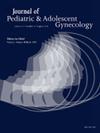16. Assessing Residents’ Knowledge of Dysmenorrhea in Adolescents and Young Adults
IF 1.7
4区 医学
Q3 OBSTETRICS & GYNECOLOGY
引用次数: 0
Abstract
Background
Our study sought to better understand residents’ knowledge of diagnosis and treatment of primary and secondary dysmenorrhea in adolescents and young adults and whether that knowledge could be improved by a brief educational intervention.
Methods
Residents in the Obstetrics and Gynecology and Pediatrics programs at the Medical University of South Carolina completed a pre-lecture survey, attended a focused lecture on dysmenorrhea, and completed a post-lecture survey. The average percent correct for the pre- and post-lecture surveys was compared.
Results
Twenty-three residents completed both the pre- and post-lecture surveys. The average score on the pre-lecture survey was 72% and the average score on the post-lecture survey was 92% (p < 0.05). Post-graduate year positively correlated with pre-lecture survey score, with PGY-1 through PGY-4 residents averaging 65%, 72%, 79%, and 82%, respectively, on the pre-lecture survey.
Conclusions
We found that an hour-long lecture resulted in a statistically significant improvement in survey scores, suggesting that a brief educational intervention can improve both comfort with and knowledge of the clinical management of these conditions. We also found that post-graduate year (PGY) positively correlated with pre-test score, suggesting that dysmenorrhea is something residents receive clinical exposure to during training and emphasizing the need for foundational education during resident didactics.
16. 居民对青少年痛经知识的评估
本研究旨在更好地了解居民对青少年和青壮年原发性和继发性痛经的诊断和治疗的知识,以及是否可以通过简短的教育干预来改善这些知识。方法南卡罗来纳医科大学妇产科和儿科专业的住院医师完成课前调查,参加痛经专题讲座,并完成课后调查。对课前和课后调查的平均正确率进行了比较。结果23名住院医师完成了课前和课后调查。课前调查的平均得分为72%,课后调查的平均得分为92% (p <;0.05)。研究生学年与课前调查得分正相关,PGY-1至PGY-4学生的课前调查平均得分分别为65%、72%、79%和82%。结论:我们发现,一小时的讲座可以显著提高调查得分,这表明简短的教育干预可以提高对这些疾病的临床管理的舒适度和知识。我们还发现,研究生学年(PGY)与考试前成绩呈正相关,这表明痛经是住院医师在培训期间接受临床接触的内容,并在住院医师教学中强调基础教育的必要性。
本文章由计算机程序翻译,如有差异,请以英文原文为准。
求助全文
约1分钟内获得全文
求助全文
来源期刊
CiteScore
3.90
自引率
11.10%
发文量
251
审稿时长
57 days
期刊介绍:
Journal of Pediatric and Adolescent Gynecology includes all aspects of clinical and basic science research in pediatric and adolescent gynecology. The Journal draws on expertise from a variety of disciplines including pediatrics, obstetrics and gynecology, reproduction and gynecology, reproductive and pediatric endocrinology, genetics, and molecular biology.
The Journal of Pediatric and Adolescent Gynecology features original studies, review articles, book and literature reviews, letters to the editor, and communications in brief. It is an essential resource for the libraries of OB/GYN specialists, as well as pediatricians and primary care physicians.

 求助内容:
求助内容: 应助结果提醒方式:
应助结果提醒方式:


